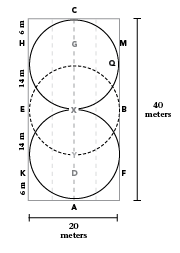Now that you have mastered the geometry of the large dressage arena and how to ride a 20-meter circle in that space (click here to read it), it is time to go smaller. It is not uncommon to come across a small arena whether in the form of a smaller indoor or a competition ring (seen through Training Level, Test 3). Knowledge of the small arena’s geometry will allow you to ride with the same increased effectiveness you experienced when you learned the layout of the large arena.

Small Arena Measurements and Markers
The small dressage arena is 20 meters wide by 40 meters long—20 meters shorter than the large arena (see diagram below). The corner letters are still 6 meters from their respective short sides. However, B and E now sit 14 meters (not 12) from those corner letters. As a result of this new geometry, you can fit only two 20-meter circles in the arena without overlapping (unlike the large arena, in which you can fit three).
This smaller space poses new challenges to your riding as many of your movements and figures will come up more quickly than if you were riding in a large arena.
For example, USDF Introductory and USEF Training Level tests sometimes require 20-meter circles to be ridden in the center of the arena, followed by a circle at the end. Instead of 30 meters from B/E to the corner, you now have only 20 meters before arriving at the short side.
You will notice that things can seem quite claustrophobic inside the small arena until you get comfortable with the space and how to ride your figures and movements, especially if you are on a larger horse.
20-Meter Circles
Let us work through the 20-meter circle at C to better prepare you for this smaller space:
1. Begin at C, tracking right.
2. Aim to arrive at the next point (marked by the letter Q on the diagram) 4 meters past M and 10 meters from the corner at M. (The circle point is halfway between B and the corner.)
3. Continue to ride a curved line to the centerline at X. Notice how your 20-meter circle is exactly half the length of the 40-meter small arena.
4. Continue your curved line to the next circle point. Aim for a point halfway between E and the corner of the arena (as you did in step 2).
5. Return to C.
To ride a 20-meter circle at A, use exactly the same principles.
Riding the 20-meter circle at E or B is another story. Here is how to ride a circle at B:
1. Begin at B, tracking right.
2. Arrive at the next point (marked by the letter Y on the diagram) 4 meters before D on the centerline.
3. Continue to ride a curved line to E.
4. Continue your curved line to the next circle point. Aim for a point 4 meters before G.
5. Return to B.
Mark all of the circle points by placing flexible training cones on either side. This will come in handy as you are learning these new locations. As with circles in the large arena, make it a point to ride straight between the cones for accuracy, but only for a few strides. Otherwise, you will end up incorrectly riding a diamond or a rounded square.
With a lot of review and mounted practice, you will be more comfortable with this new small arena and how to ride 20-meter circles in this space. Once you have mastered this skill, you will have a better understanding of where to place other geometric figures in a 20-by-40-meter arena.
This work will prepare you for next month, when we will be addressing more difficult figures in the small and large arena.
Until then, happy riding!
To read the entire Dressage 101 series, click here.
This article originally appeared as part of a monthly series on Dressage 101 topics.
Hilary Moore Hebert is a professional dressage trainer with clients from green to FEI. A USDF bronze and silver medalist, as well as “L” Education Program graduate, she owns and operates Moore Hebert Dressage at Alsikkan Farm in Germantown, Maryland.











